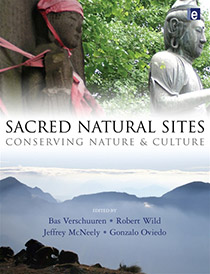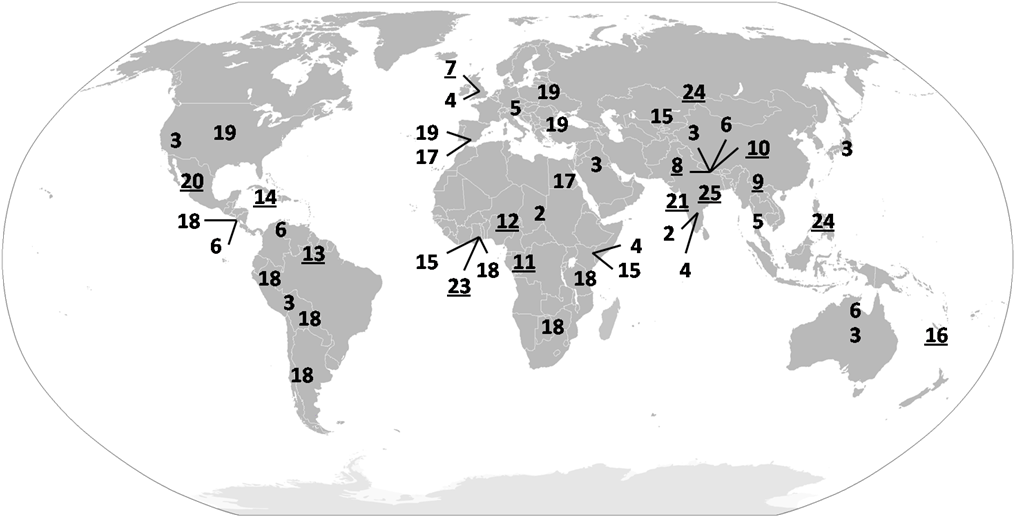Am beth mae'r llyfr?
Safleoedd Naturiol Sacred yn lleoedd ddiogelir hynaf y byd. Mae'r llyfr hwn yn canolbwyntio ar amrediad eang o enghreifftiau eiconig ac yn llai adnabyddus megis llwyni cysegredig y Western Ghats (India), Sagarmatha / Chomolongma (Mt Everest, Nepal, Tibet - a Tsieina), Mynyddoedd Aur Altai (Rwsia), Ynys Cybi o Lindisfarne (DU) a llynnoedd sanctaidd y Delta Niger (Nigeria).Mae'r llyfr yn dangos bod safleoedd naturiol cysegredig, er yn aml o dan fygythiad, bodoli o fewn a thu allan i ardaloedd gwarchodedig a gydnabyddir yn ffurfiol, Safleoedd Treftadaeth. Mae'n ddigon posib mai safleoedd naturiol cysegredig yw rhai o'r cadarnleoedd olaf ar gyfer adeiladu rhwydweithiau gwydn o dirweddau cysylltiedig. Maent hefyd yn ffurfio nodau pwysig ar gyfer cynnal ffabrig cymdeithasol-ddiwylliannol deinamig yn wyneb newid byd-eang. Mae'r awduron amrywiol yn pontio'r bwlch rhwng dulliau o gadwraeth amrywiaeth ddiwylliannol a biolegol trwy ystyried gwerthoedd diwylliannol ac ysbrydol ynghyd â buddiannau economaidd-gymdeithasol y cymunedau ceidwad a rhanddeiliaid perthnasol eraill.
Gwersi a ddysgwyd
Dysgwyd llawer o wersi o'r llyfr a'r prosesau sydd wedi cyfrannu at ei luniad. Mae'r gwersi hyn wedi arwain at ddatblygiad y Cynllun Gweithredu ar gyfer Cadwraeth Safleoedd Naturiol Cysegredig sy'n llywio gweithredoedd y safleoedd naturiol cysegredig yn cychwyn. Y canlynol 10 Esbonnir gwersi a ddysgwyd ar wefannau naturiol cysegredig ymhellach ym mhennod olaf y llyfrau:- Mae safleoedd naturiol cysegredig wedi gwasanaethu ers amser maith fel rhwydwaith sylfaenol o ecosystemau ar gyfer gwarchod natur a diwylliant.
- Mae diraddiad cyflym a cholli safleoedd naturiol cysegredig yn bygwth bioamrywiaeth beirniadol yn ddifrifol, Gwasanaethau Ecosystem, adnoddau diwylliannol a hyd yn oed ffyrdd o fyw.
- Mae cydnabod safleoedd naturiol cysegredig yn cefnogi ymreolaeth gymunedol, yn hyrwyddo rheolaeth effeithiol ac yn rhoi llais, hawliau a gweithredu i bobl leol.
- Ffydd, Mae ysbrydolrwydd a gwyddoniaeth yn darparu ffyrdd gwahanol ond cyflenwol o wybod a deall perthnasoedd natur ddynol.
- Brif ffrwd, Mae gan grefyddau ac ysbrydoliadau gwerin a brodorol gymhleth, weithiau perthnasoedd sy'n gwrthdaro; Gwell parch at ei gilydd ac mewn rhai achosion mae angen rapprochement ar gyfer gofal ar y cyd o safleoedd naturiol cysegredig.
- Mae angen gwell dealltwriaeth o'u cydberthynas ar gyd-fodolaeth llwyddiannus safleoedd naturiol cysegredig a gorchmynion economaidd modern, ac o werthoedd a buddion eang safleoedd naturiol cysegredig ar gyfer lles a datblygu dynol.
- Safleoedd naturiol cysegredig fel nodau gwytnwch, Mae adfer ac addasu i newid yn yr hinsawdd yn cynnig cyfleoedd i wella'n ecolegol gadarn, Ffyrdd lleol o fyw.
- Mae angen cynnwys safleoedd naturiol cysegredig yn ymwybodol fel rhan o ymateb cydlynol a chydlynol i newid byd -eang.
- Ymrwymiad Lleol, Ymwybyddiaeth gyhoeddus eang, polisïau a deddfau cenedlaethol cefnogol, Mae amddiffyn y wladwriaeth a chefnogaeth ryngwladol eang yn hanfodol ar gyfer goroesiad safleoedd naturiol cysegredig.
- Strategaeth eang ar gyfer gwarchod safleoedd naturiol cysegredig, Mae angen diffinio'r camau blaenoriaeth sy'n ofynnol ac adeiladu clymblaid fyd -eang i gyflawni'r gweithredoedd hyn ar frys.
Map o leoliadau
Map y Byd yn cysylltu lleoliad bras safleoedd naturiol cysegredig â'r penodau yn y llyfr: (Ffynhonnell: Bas Verschuuren yn Verschuuren et al 2010)
Sut i gael y llyfr
Gellir archebu'r llyfr Safleoedd Naturiol Cysegredig yn uniongyrchol trwy'r Gwefan Routledge. Nghefnwr, Mae opsiynau clawr meddal ac eLyfr ar gael.Llyfr Prynu »
I ofyn am gopi PDF gan y golygyddion at ddibenion anfasnachol e-bostiwch e-bost info@sacrednaturalsites.org
Gofyn am gopi pdf »
Ardystiadau
Julia Marton-Lefèvre
Cyfarwyddwr Cyffredinol, Undeb Rhyngwladol Cadwraeth Natur, Chwarren, SwistirMae'r llyfr hwn yn cael ei gyhoeddi ym mlwyddyn ryngwladol bioamrywiaeth, sy'n rhoi pwysigrwydd arbennig iddo fel mynegiant o'r berthynas arbennig rhwng pobl a gweddill natur. Mae'n cynnig cyfle inni atgoffa ein hunain o'r perthnasoedd dwfn ac ystyrlon sydd gan lawer o grefyddau a chymunedau ffydd â natur, a ddangosir gan eu defosiwn i safleoedd naturiol cysegredig fel y rhai a ddisgrifir ar y tudalennau hyn.
Yr Athro Alastair McIntosh
Canolfan Ecoleg Ddynol, Prifysgol Strathclyde, DU ac awdur pridd ac enaidOs yw gwyddoniaeth i wasanaethu bywyd ar y blaned hon, Mae angen mwy na thrylwyredd deallusol arnom, Mae angen egni moesegol arnom hefyd. Mae hynny'n mynnu gwerthoedd. Ond beth allai hysbysu'r rhain? Un sail yw'r hyn y mae profiad dynol wedi'i alw'n “The Sacred”. I rai, Mae “The Sacred” yn gysyniad damcaniaethol. I eraill, Mae'n swyddogaeth o brofiad empirig mewn ymwybyddiaeth. Y naill ffordd neu'r llall, Mae'r garreg filltir hon o lyfr yn dangos y gall yr effaith ar gadwraeth natur fod yn hynod gadarnhaol, gwahodd beirniadaeth a gwerthfawrogiad ysgolheigaidd.
Berkes Fikret
Cadeirydd Ymchwil Athro Nodedig a Chanada ym Mhrifysgol Manitoba, ac awdur ecoleg gysegredigMae safleoedd naturiol cysegredig yn chwaraeon cast a chryno rhyngwladol i gyd, penodau dim-llol. Mae'r astudiaeth o ardaloedd naturiol cysegredig wedi dod i oed, A dyma'r llyfr i'w brofi.
Ydych chi wedi darllen y llyfr? E-bost: info@sacrednaturalsites.org A dywedwch wrthym am eich canfyddiadau!





